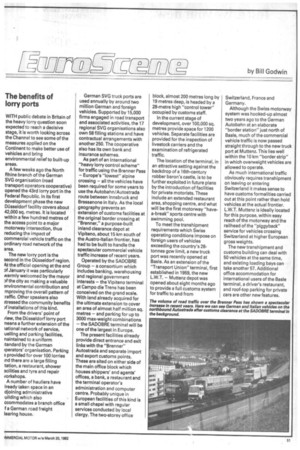by Bill Godwin
Page 47

If you've noticed an error in this article please click here to report it so we can fix it.
The benefits of lorry ports
WITH public debate in Britain of the heavy lorry question soon expected to reach a decisive stage, it is worth looking across the Channel to see some of the measures applied on the Continent to make better use of vehicles and bring environmental relief to built-up areas.
A few weeks ago the North Rhine branch of the German SVG organisation (road transport operators cooperative) opened the 43rd lorry port in the Federal Republic. In its first development phase the new Dusseldorf facility covers about 42,000 sq. metres. It is located within a few hundred metres of the access point to a major motorway intersection, thus reducing the impact of commercial vehicle traffic on the ordinary road network of the area.
The new lorry port is the second in the Dusseldorf region. At the official opening at the end of January it was particularly ',warmly welcomed by the mayor of the city as making a valuable 3nvironmental contribution and mproving the overall pattern of :raffic. Other speakers also ;tressed the community benefits A installations of this kind. From the drivers' point of riew, the DOsselclorf lorry port neans a further extension of the iational network of service, uelling and parking facilities, naintained to a uniform ,tandard by the German iperators' organisation. Parking s provided for over 100 lorries Ind there are a large filling tation, a restaurant, shower acilities and tyre and repair workshops.
A number of hauliers have lready taken space in an djoining administrative uilding which also ccommodates a branch office f a German road freight fearing house. German SVG truck ports are used annually by around two million German and foreign vehicles. Supported by 15,000 firms engaged in road transport and associated activities, the 17 regional SVG organisations also own 58 filling stations and have contractual arrangements with another 250. The cooperative also has its own bank and insurance schemes.
As part of an international "heavy lorry control scheme" for traffic using the Brenner Pass — Europe's "lowest" alpine crossing — all the vehicles have been required for some years to use the Autobahn/Autostrada route between Innsbruck and Bressanone in Italy. As the local geography prevents an extension of customs facilities at the original border crossing at "Brenner," a purpose-built inland clearance depot at Vipiteno, about 15 km south of the Austro-Italian frontier, has had to be built to handle the spectacular commercial vehicle traffic increase of recent years.
Operated by the SADOBRE Group — a consortium which includes banking, warehousing and regional government interests — the Vipiteno terminal at Campo die Trens has been conceived on the grand scale. With land already acquired for the ultimate extension to cover an area of almost half million sq. metres — and parking for up to 3000 max-weight combinations — the SADOBRE terminal will be one of the largest in Europe.
The present facilities already provide direct entrance and exit links with the "Brenner" Autostrada and separate import and export customs points. These are sited on either side of the main office block which houses shippers' and agents' offices, a bank, a restaurant and the terminal operator's administration and computer centre. Probably unique in European facilities of this kind is a small chapel with regular services conducted by local clergy. The two-storey office block, almost 200 metres long by 19 metres deep, is headed by a 28-metre high "control tower" occupied by customs staff.
In the current stage of development, over 100,000 sq. metres provide space for 1200 vehicles. Separate facilities are provided for the inspection of livestock carriers and the examination of refrigerated traffic.
The location of the terminal, in an attractive setting against the backdrop of a 16th-century robber baron's castle, is to be further exploited in future plans by the introduction of facilities for private motorists. These include an extended restaurant area, shopping centre, and what will be the first motorway "havea-break" sports centre with swimming pool.
To meet the transhipment requirements which Swiss operating conditions impose on foreign users of vehicles exceeding the country's 28tonnes gcw limit, a new truck port was recently opened at Basle. As an extension of the "Transport Union" terminal, first established in 1959, the new L.W.T. — Muttenz depot was opened about eight months ago to provide a full customs system for traffic to and from Switzerland, France and Germany.
Although the Swiss motorway system was hooked-up almost two years ago to the German Autobahn at an elaborate "border station" just north of Basle, much of the commercial vehicle traffic is now passed straight through to the new truck port at Muttenz. This lies well within the 10 km "border strip" in which overweight vehicles are allowed to operate.
As much international traffic obviously requires transhipment on leaving or entering Switzerland it makes sense to have customs formalities carried out at this point rather than hold vehicles at the actual frontier.
Muttenz is ideally located for this purpose, within easy reach of the motorway and the railhead of the "piggyback" service for vehicles crossing Switzerland at higher European gross weights.
The new transhipment and customs building can deal with 50 vehicles at the same time, and existing loading bays can take another 57. Additional office accommodation for international users of the Basle terminal, a driver's restaurant, and roof-top parking for private cars are other new features.
















































